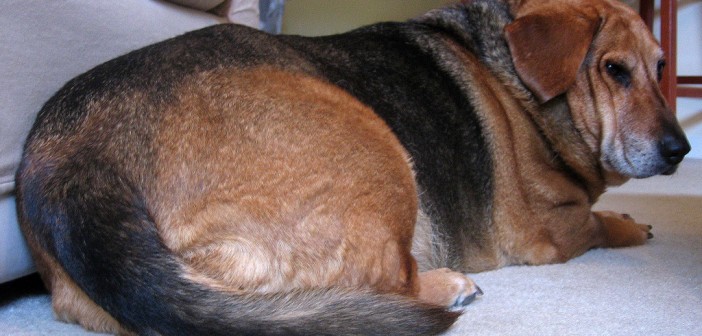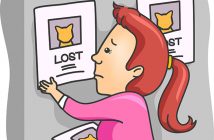Most of us think of our companion pets as part of the family. They play with us, sit with us while we watch TV, and some even sleep with us. It only seems natural to want to include them in our mealtimes by feeding them table scraps. Unfortunately, as with people, extra pounds can lead to physical problems, such as joint problems, diabetes, and cardiovascular disease. Most indoor cats and many dogs do not receive adequate daily physical activity. According to the Center for Disease Control and the Association for Pet Obesity Prevention:
- approximately 68% of US households own at least one pet,
- 64% of adult Americans are overweight or obese,
- 57.9% of cats and 52.7% of dogs are overweight or obese.
How can you tell if your companion is overweight? Take a good, hard look at her and see which of the following categories match her body type.
Ideal Weight: Her ribs and spine are easily felt, but not necessarily seen. Her waist is visible when viewed from above. Her abdomen should be raised, not sagging, when viewed from the side.
Overweight: Her ribs and spine are hard to feel underneath the fat. Her waist is distended or pear-shaped when viewed from above. Her abdomen sags when seen from the side.
Obese: She has large fat deposits over her chest, back, tail base and hindquarters. Her abdomen sags prominently, and there is no waist when viewed from above.

Americans purchase over 8 million tons of companion food every year. We spent an all-time high of $55.7 billion in 2014 and spending is predicted to reach $60 billion this year. Free choice feeding is one of the top contributors to obesity, which is why you should keep pets on a feeding schedule. Most veterinarians recommend feeding your cat or dog twice a day.
We also give our companions treats every time they do a trick or make a cute face, not thinking about the health problems we are creating. Some of the health risks are osteoarthritis, insulin resistance and diabetes, high blood pressure, heart and respiratory disease, ligament injuries, kidney disease, many forms of cancer, and decreased life expectancy. Besides the fact that your companion is miserable and sickly, the cost of medications and surgeries can be prohibitively expensive.
If your companion is overweight or obese, how do you choose the right diet for her? The first and best resource is your veterinarian, who knows your companion’s health and what she needs. It is also important to choose a brand of food that:
- has a veterinarian nutritionist on staff with a consumer phone number,
- has an AAFCO* statement that the product provides the minimum daily nutrition,
- and a company that conducts feeding trials.
Calories in Cat Food
A healthy, active 8-pound adult cat requires about 30 calories per pound a day, which calculates to about 240 calories a day. Most dry food contains about 300 calories per cup, and wet food contains about 250 calories in each 6-ounce can. Therefore, she would need 4/5 of a cup of dry food or a little less than a 6-ounce can of wet food each day. You can adjust the portions based on her activity level and her body category.
Calories in Dog Food
Your veterinarian can tell you how many calories your canine companion needs to consume based on her breed, age, and activity level. Some dog food brands provide caloric content on the package and on their product websites, or will provide it if you call or write them. Dry food contains roughly 97 calories per ounce; semi-moist dog food is about 85 calories per ounce; and wet food is around 25 calories per ounce. Fat contains roughly 8.5 calories per gram. Carbohydrates and proteins are about 3.5 calories per gram.
- Multiply the fat percentage listed on the package by 8.5.
- Multiply the carbohydrate and protein percentages listed on the package by 3.5.
- Add the numbers. The final sum is about the number of calories per gram in the dry food.
Typical Costs for Your Canine Companion’s Food
Portioning out the food will keep your companion from overeating. Keeping your companion slim will provide a longer and better quality of life for her and you will save money too.
*The American Association of Feed Control Officials (AFFCO) have food guidelines manufactures must adhere to in order to use words like “Light,” “Low Calorie,” “Reduced Calories,” “Low Fat,” etc.…
By Mona Mistric




